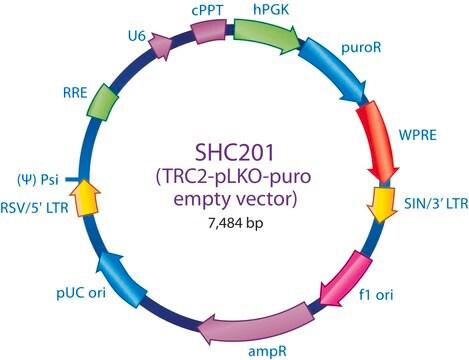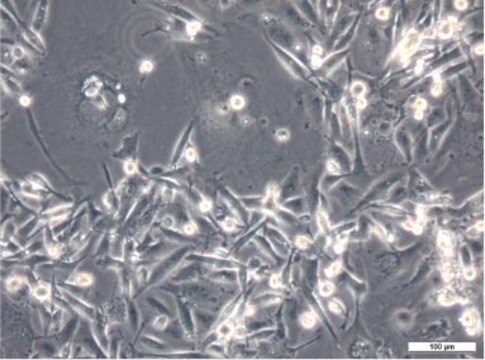추천 제품
일반 설명
The MISSION® shRNA product line is centered on a transfer vector-based RNAi library against annotated mouse and human genes that can be used in conjunction with this Lentiviral Packaging Mix. In this packaging system, the pseudo-typing with VSV-G broadens the viral tropism associated with the virus. Therefore, these lentiviral particles can efficiently deliver the transfer sequence of interest to a wide variety of cell types, including primary and non-dividing cells.
The MISSION® Lentiviral Packaging Mix is an optimized formulation of two plasmids expressing the key HIV packaging genes and a heterologous viral envelope gene.
Lentiviral particles are generated from three main components:
The Lentiviral Packaging Mix contains the first two components; it is designed to be co-transfected along with a compatible lentiviral transfer vector in order to create high-titer pseudo-typed lentiviral particles used for downstream transduction applications.
The MISSION® Lentiviral Packaging Mix is an optimized formulation of two plasmids expressing the key HIV packaging genes and a heterologous viral envelope gene.
Lentiviral particles are generated from three main components:
- The packaging vector, which contains the minimal set of lentiviral genes required to generate the virion structural proteins and packaging functions.
- The vesicular stomatitis virus G-protein envelope vector, which provides the heterologous envelope for pseudotyping.
- The shRNA transfer vector, which contains the sequence of interest as well as the cis acting sequences necessary for RNA production and packaging.
The Lentiviral Packaging Mix contains the first two components; it is designed to be co-transfected along with a compatible lentiviral transfer vector in order to create high-titer pseudo-typed lentiviral particles used for downstream transduction applications.
애플리케이션
MISSION® Lentiviral Packaging Mix has been used to incubate plasmids before addition to human embryonic kidney cells 293 expressing the large T antigen (293T cells) and to pack lentivirus into 293T cells.
기타 정보
Lentiviral particles are produced using a third-generation packaging system, which has many features that lead to enhanced biosafety. Recombinant lentiviruses produced with the MISSION Lentiviral Packaging Mix have not been shown to produce replication competent viral particles because of designed safety features. Users should consult and observe their own institutional guidelines before working with such viral systems.
법적 정보
Use of this product is subject to one or more license agreements. For details, please see http://sigmaaldrich.com/missionlicense .
MISSION is a registered trademark of Merck KGaA, Darmstadt, Germany
Storage Class Code
10 - Combustible liquids
WGK
WGK 2
Flash Point (°F)
Not applicable
Flash Point (°C)
Not applicable
가장 최신 버전 중 하나를 선택하세요:
이미 열람한 고객
NIH Guidelines for Research Involving Recombinant DNA Molecules
N.I.H. Memorandum (2002)
T Dull et al.
Journal of virology, 72(11), 8463-8471 (1998-10-10)
Vectors derived from human immunodeficiency virus (HIV) are highly efficient vehicles for in vivo gene delivery. However, their biosafety is of major concern. Here we exploit the complexity of the HIV genome to provide lentivirus vectors with novel biosafety features.
Toufik Abbas-Terki et al.
Human gene therapy, 13(18), 2197-2201 (2003-01-25)
RNA interference (RNAi) is a form of posttranscriptional gene silencing mediated by short double-stranded RNA, known as small interfering RNA (siRNA). These siRNAs are capable of binding to a specific mRNA sequence and causing its degradation. The recent demonstration of
Wenwen Chien et al.
Journal of Cancer, 9(24), 4762-4773 (2018-12-28)
This study is an unbiased genomic screen to obtain functional targets for increased effectiveness of dasatinib in pancreatic cancer. Dasatinib, a multi-targeted tyrosine kinase inhibitor, is used in clinical trials for treatment of pancreatic cancer; however, intrinsic and acquired resistance
Helen He et al.
Journal of biomarkers, 2016, 1274603-1274603 (2016-06-02)
Objective. Use of tyramide signal amplification (TSA) to detect autophagy biomarkers in formalin fixed and paraffin embedded (FFPE) xenograft tissue. Materials and Methods. Autophagy marker regulation was studied in xenograft tissues using Amp HQ IHC and standard IHC methods. Results.
문서
MISSION shRNA reduce the expression of specific target genes by targeting the specific mRNA therefore reducing the corresponding protein expression.
MISSION shRNA reduce the expression of specific target genes by targeting the specific mRNA therefore reducing the corresponding protein expression.
프로토콜
Preparation of the Lentiviral Transduction Particles Using Packaging Plasmid Mix
자사의 과학자팀은 생명 과학, 재료 과학, 화학 합성, 크로마토그래피, 분석 및 기타 많은 영역을 포함한 모든 과학 분야에 경험이 있습니다..
고객지원팀으로 연락바랍니다.








